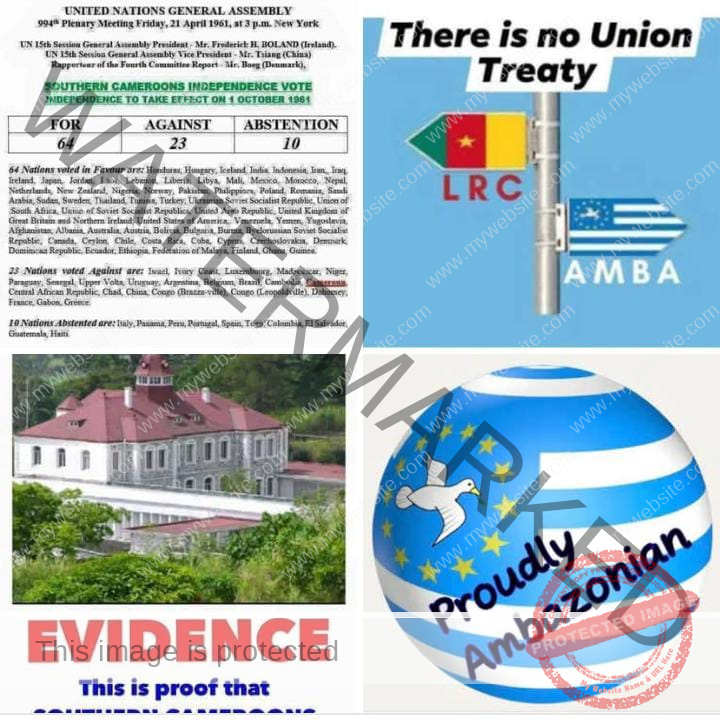Treaties Securing Southern Cameroons’ Boundaries are well known, with La République du Cameroun: The 1917 Alfred Milner–Henry Simon Treaty, confirmed by the Versailles Treaty (1919), and Boundary with Nigeria: The Anglo-German treaties of 11 March 1913 and 12 April 1913.
By The Southern Cameroons (Ambazonia) Students’ Caucus, Buea
NB: Ambazonia is the name Southern Cameroons has adopted to distinguish itself from the southern part of La République du Cameroun.
The October 1, Harassments.
Every year on October 1, La République du Cameroun harasses, arrests, and imprisons Southern Cameroonians (Ambazonians) who attempt to celebrate their independence day.
To understand why the recurrence, we must examine international law and the process of decolonization as explained by The Hague Academy of International Law.
Decolonization and the Importance of the Date of Independence
At a conference organized by The Hague Academy of International Law at the University of Montreal (July 8, 2024) on International Law and Uncompleted Decolonization, it was emphasized that decolonization begins when the administering authority resolves to grant independence and selects a date for independence.
That date is critical: it confers to the new state its territorial boundaries under the Latin maxim uti possidetis juris — meaning, “what you possess as territory at the time of independence is yours.”
In Africa, this principle was reinforced by:
The OAU’s 1963 decision on the inviolability of inherited colonial borders;
The ICJ’s 1986 judgment in the Mali v. Burkina Faso case;
Article 4(b) of the Constitutive Act of the African Union (2000), affirming that state boundaries are those inherited at independence.
La République du Cameroun ratified this Act at the AU summit in Sirte, Libya (1999).
UN Resolutions on Cameroun and Southern Cameroons
French Cameroun (La République du Cameroun): Granted independence by UN Resolution 1349 (XIII) of 13 March 1959, with January 1, 1960 as its independence date.
British Southern Cameroons: Granted independence by UN Resolution 1608 (XV) of 21 April 1961, with October 1, 1961 as its independence date.

Thus, both entities became independent states with their own territories and immutable boundaries.
Treaties Securing Southern Cameroons’ Boundaries
Boundary with La République du Cameroun: The 1917 Alfred Milner–Henry Simon Treaty, confirmed by the Versailles Treaty (1919).
Boundary with Nigeria: The Anglo-German treaties of 11 March 1913 and 12 April 1913.
These boundaries, recognized at independence, are legally binding and intangible under international law.
Why October 1 Is Suppressed
The suppression of October 1 stems from the following realities:
Southern Cameroons and La République du Cameroun were two independent states before forming a federation in 1961. A federation can only exist between sovereign states, not between a sovereign state and a colony.
Southern Cameroons, having gained independence in 1961, cannot legally be reduced to “North West and South West Regions” of La République du Cameroun.
The claim of “One and Indivisible” Cameroon contradicts the principle of intangibility of boundaries established by the UN and ICJ.
Southern Cameroons cannot lawfully be downgraded to a “Special Status Territory,” unlike French overseas departments.
The February 11, 1961 plebiscite did not nullify Southern Cameroons’ independence granted by the UN on October 1, 1961.
The Fraud of May 20, 1972
President Ahidjo’s 1972 referendum abolished the federation in violation of Article 47 of the 1961 Federal Constitution. Critics across La République du Cameroun itself recognize May 20 as:
A fraudulent “Unification Day” (Albert Dzongang, CPDM politician);
A constitutional coup d’état (Louis Noé Rigobert Mbangan Nkainje, journalist and sociologist);
A day that “swallowed Anglophones” (Barrister Tsapy Lavoisieur, advocate at the Supreme Court of Cameroon).
Even official contradictions exist: in 2024, the Cameroonian Ambassador to the U.S. described May 20 as “Independence Day,” directly contradicting UN records that fixed La République du Cameroun’s independence as January 1, 1960.
The Political Motive Behind October 1 Repression
Harassment on October 1 seeks to:
Hide from Francophones that Southern Cameroons was a distinct state with independence;
Uphold the fiction of a “One and Indivisible” Cameroon;
Preserve the fraudulent legacy of May 20, 1972;
Protect French interests in the region despite declining influence in Africa.
Indeed, France demonstrated this in 1992 when Ni John Fru Ndi, an Anglophone, won the presidential elections. President Mitterrand of France dispatched Charles Pasqua to Yaoundé with the message: “An Anglophone can never be President in La République du Cameroun.” Fru Ndi was subsequently placed under house arrest and Biya declared winner.
Conclusion
Southern Cameroonians are harassed, arrested, and imprisoned every October 1 to erase from memory the truth that:
Southern Cameroons was independent like La République du Cameroun;
Its boundaries are legally distinct and immutable;
Its people cannot legally be reduced to provinces, regions, or “special status” within La République du Cameroun.
This suppression sustains a falsehood — that two sovereign states became one indivisible country without any lawful treaty — a narrative that collapses under international law.
The Southern Cameroons (Ambazonia) Students’ Caucus, Buea